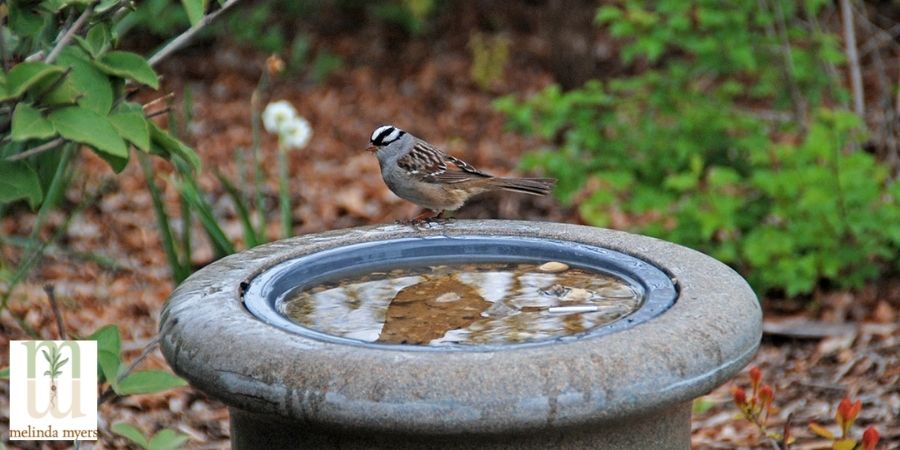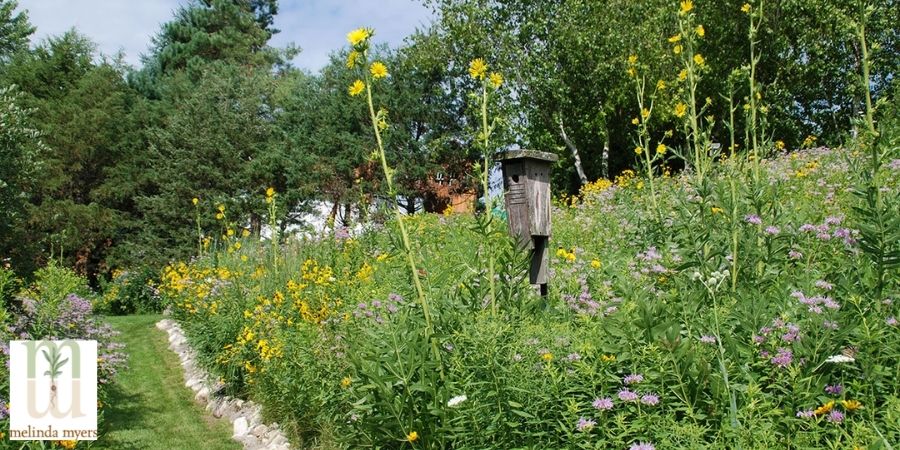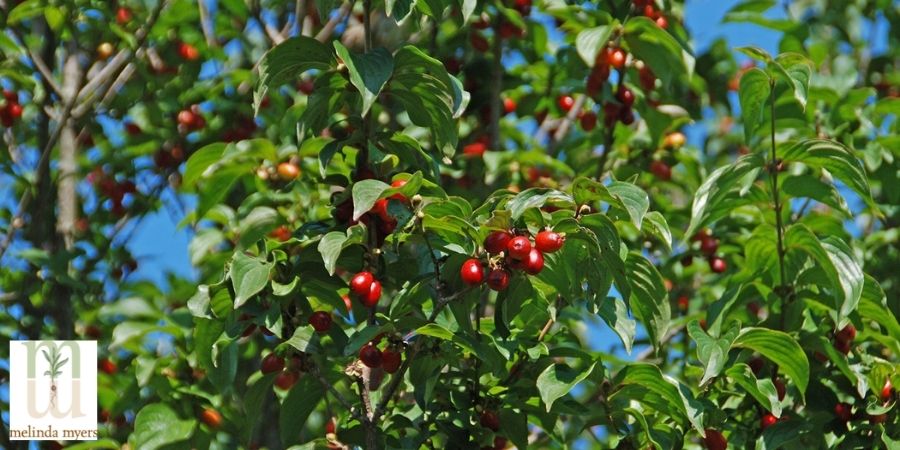Plant and Grow a Bird-Friendly Landscape
- horticulturist and gardening expertOctober 9, 2021
It is not surprising more and more people are involved in both bird watching and gardening. Landscaping for birds creates gardens filled with flowers, trees, and shrubs that we can enjoy while providing food and shelter for birds we love to watch. Both pursuits help connect us with nature, reduce stress, and elevate our mood.
Keep birds in mind as you plan additional gardens, renovate a tired landscape, and whenever adding new plants to your landscape. Many of the strategies we employ for designing a healthy landscape also help attract songbirds.
Design Ideas for a Bird-Friendly Landscape
Grow shrubs in groups to create an attractive display and bird sanctuary. Plant flowers, that provide seed and nectar for birds, in clusters. Larger groupings create greater visual impact in the landscape and make for easier dining. The birds will waste less energy traveling between the plants when the food sources are growing close together.
Include plants with year-round appeal. Evergreens provide a green backdrop for other plants and shelter for birds all year round. But deciduous trees and shrubs, those that lose their leaves in winter, can provide multiple seasons of beauty with flowers, fruit, and fall color. Many of these also provide shelter and food for songbirds.
Planting a beautiful and diverse collection of plants that provide a variety of food sources helps attract a wider range of birds. It also helps reduce the risk of an insect or disease wiping out a large portion of your plantings. Many of you may be familiar with Dutch Elm Disease that has killed over 40 million American elms and Emerald Ash Borer that has killed millions of trees and remains a threat to the billions of ash trees growing in our landscapes, urban forests and woodlands.
Plant a Landscape that Feeds Birds
Plan a landscape that provides food for seasonal visitors as well as those year-round residents. Plants are nature’s bird feeders that do not require cleaning or restocking.
Check range maps in field guides to help you identify and prepare for birds that may end up in your yard. Boosting food sources during spring and fall migration helps birds recharge on their long journeys. Providing food year-round supports those birds nesting and overwintering in your landscape.
Select native trees, shrubs, and flowers whenever appropriate. Native plants, birds, and insects have co-evolved over time. This makes native plants a great source of food and shelter for native birds. The native insects these plants attract provide an important source of protein for the 96 percent of terrestrial North American birds that feed upon them.
Supplement food as needed throughout the year. Stock the appropriate style of feeders with the type of food preferred by the birds you are trying to attract. Site feeders carefully to avoid window collisions but in areas where they can easily be viewed, filled, and cleaned. Plant trees and shrubs nearby to provide protective covering from hawks, feral cats, and other predators.

Provide Water for Backyard Birds
Bring birds to your yard by including a birdbath or two in your garden. Clean and dependable sources of water are critical for drinking and bathing. Adding a birdbath to your landscape can also help attract birds that don’t eat seeds and wouldn’t otherwise visit your garden.
Select a shallow birdbath with gently sloping sides that allows birds to take a sip of water without getting all wet. Or set a few stones in a deeper birdbath to accomplish the same result. Cornell’s All About Birds suggests making your own shallow birdbath from a trash can lid, shallow pan, saucer type snow sled, or frying pan.
Make your birdbath more appealing by providing dripping water. You can purchase a bird fountain, commercial dripper, or sprayer or make your own. Just punch a hole in the bottom of a metal bucket or plastic container, hang it above the birdbath and fill it with water.
Change the water every day or two to keep it clean, safe for drinking, and prevent mosquitoes from breeding. I change the water in my birdbaths every time I water my containers. Making it part of another gardening routine makes it easy to remember and do.
Warm water and a scrub brush is a safe way to remove any algae that collect on the surface of the birdbath. The Audubon Society recommends rinsing and scrubbing birdbaths as needed with a 9 parts water to one-part vinegar solution. Rinse then fill with fresh water.
Providing water in cold winter climates is important for birds residing in those landscapes year-round. You can purchase a heated birdbath or use an immersion heater in a cold-weather-resistant birdbath. Or set out a plastic bowl filled with water at the same time each day. Bring it back inside once it freezes.
Create Shelter for Birds in Your Backyard
Take a clue from nature when creating plantings that provide shelter for birds to rest, nest, and escape from predators. Dense shrub plantings create thickets many birds prefer. It also provides colorful screening and living boundaries in the yard.
Vines can dress up a blank wall, fences, and arbors while providing food and shelter for birds. Provide strong supports and avoid damage by keeping vines off wood homes and siding.
Leave dead branches and tree trunks that do not present a hazard in the landscape. These provide homes for cavity nesters like Blue Jays and woodpeckers. The insects that feed in these are a source of food for chickadees, nuthatches, and woodpeckers. Dress up standing dead tree trunks with a vine that adds food and cover for the songbirds.
Create a brush pile to shelter birds from harsh weather. Start with a 2’ high layer of thick branches. Cover this with a 2’ layer of thinner branches. Top off the pile with thin evergreen branches for a bit more protection.

Birdhouses provide additional nesting sites for a variety of birds. About 3 dozen North American cavity-nesting bird species will also nest in birdhouses. A durable nesting box has thick walls made from untreated wood, holes for ventilation and drainage, sloped and extended roof, and baffle to keep out raccoons, snakes, cats, and other predators.
Birdhouses need to be the right size with the proper opening for the birds you are trying to support. Wildlife expert and author, George Harrison, provides specifics in the National Wildlife article Choose the Right Birdhouse.
Managing Pests with Birds in Mind
Birds, toads, frogs, and salamanders are great gardening partners. They eat a variety of insects helping gardeners manage insect pests. But you must tolerate a bit of damage so the birds have this protein-rich source of food.
Patience is important. Give nature’s pest controllers time to eat up the problem. Songbirds have eliminated pine needle scale on my mugo pines, oyster shell scale on houseplants summering outdoors and the hummingbirds keep the aphids on my honeysuckle trumpet vine under control.
If you must intervene try removing the pests by hand, smashing or dropping them into a can of soapy water. A strong blast of water will dislodge aphids and mites. If your plants are suffering and beneficial insects and birds are not providing needed control, use organic insecticidal soap or lightweight horticulture oil. These only kill what they contact and won’t injure birds that stop by later to dine on the insect pests.
Selecting Plants for a Bird-Friendly Landscape
When selecting plants for your landscape make sure they are suited to the growing conditions and will fit the available space once they reach their mature size. Check with your University Extension service, local nature center, and Audubon’s Native Plant Database for lists of plants suited to your location.
Here are just a few of the many plants to consider. Species of the larger groups identified here may vary in hardiness and preferred growing conditions. Select the ones best suited to your region and landscape environment.
Evergreens provide year-round shelter:
- Arborvitae (Thuja) Full to part sun, moist well-drained soil, shelter from winter wind and sun, susceptible to deer
- Junipers (Juniperus)–Full sun, well-drained soil
- Spruce (Picea)– Full sun, moist well-drained soil
- Pines (Pinus)– Full sun, well-drained soil
- Canadian Hemlock (Tsuga canadensis) - Tolerates shade, moist well-drained soil, shelter from winter wind and sun

Dogwoods (Cornus)
Trees and Shrubs with fruit the birds prefer:
- Bayberry (Myrica) – Full sun to part shade, sandy to clay acidic soil
- Beautyberry (Callicarpa) – Full sun to light shade, moist well-drained soil
- Buttonbush (Cephalanthus) – Full sun, moist to wet soil
- Cherry or Plum (Prunus) – Full sun, moist well-drained soil
- Chokeberry (Aronia) – Full sun to part shade, moist to wet and dry soil
- Crabapple (Malus)- Full sun, moist well-drained soil
- Dogwoods (Cornus) – Full sun to part shade, moist soil
- Elderberry (Sambucus) – Full sun, moist to dry soils
- Hawthorn (Crataegus) – Full sun, well-drained soil
- Oak (Quercus) – Full sun, well-drained soil
- Rose (Rosa) – native species, Full sun, well-drained soil
- Serviceberry (Amelanchier) – Full sun to part shade, moist well-drained soil
- Viburnum (Viburnum) – Full sun to shade, moist well-drained drained soil
- Winterberry (Ilex verticillata) – Full sun to lightshade, moist to wet acidic soil, need one male and females for fruit
Vines
- American Bittersweet (Celastrus scandens) - full sun, well-drained soil, need one male and females for fruit or the self-fertile ‘Autumn Revolution’, aggressive
- Virginia creeper (Parthenocissus quinquefolia) – full sun to shade, well-drained, aggressive
- Wild grapes (Vitis) – Full sun, moist well-drained soil, aggressive
Native Perennials with seeds for birds
- Aster – Full to part sun, moist well-drained soil
- Bee Balm (Monarda) – Full to part sun, moist to dry soil
- Black-eyed Susan (Rudbeckia) – Full to part sun, moist well-drained soil
- Gayfeather (Liatris) – Full sun, moist well-drained soil
- Goldenrod (Solidago) – Full sun, well-drained soil
- Little Bluestem (Schizachyrium) - Full sun, well-drained to dry soil
- Purple Coneflower (Echinacea) – Full to part sun, well-drained soil
- Switchgrass (Panicum) – Full sun, moist well-drained to dry
Including bird-friendly plants, water, and nesting boxes are sure ways to attract a variety of birds to your landscape. Your efforts will be rewarded with seasons and decades of entertainment and beauty you can enjoy right outside your backdoor.
Other Resources
- Landscaping for Wildlife, Minnesota Department of Natural Resources
- Garden Butterflies of North America by Rick Mikula
- National Audubon Field Guides to North American Butterflies
- The Sibley Guide to Birds by David Allen Sibley
- Attracting Birds, Butterflies, and Other Winged Wonders to Your Backyard by Kris Wetherbee

